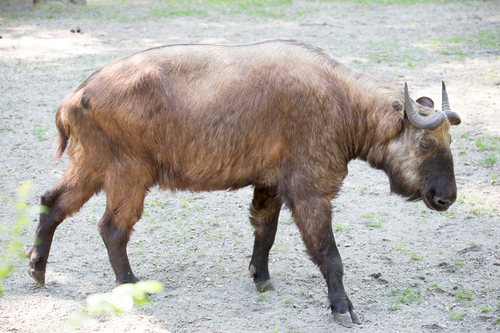
Takin
The takin, with its striking golden coat and curved horns, roams the misty Himalayan highlands. As a social grazer, it plays a vital role in maintaining the mountain ecosystem. This elusive yet majestic creature is a symbol of resilience, thriving amidst the rugged, enchanting landscapes of its alpine home.
20 years
Lifespan
350.0 kg
Weight
Length: 1.5 - 2.2 m; Height: 1.0 - 1.14 m
Size
Brown, Grey, Yellow, Black, White, Gold
Color
30 months
Age of Sexual Maturity
1-2 months
Age of Weaning
Vulnerable
Conservation Status
Decreasing
Population Trend
Characteristics
Budorcas taxicolor, commonly known as the takin, is a large ungulate native to the Eastern Himalayas. It possesses a robust body, thick golden or brownish fur, and uniquely shaped horns that curve backwards and upwards. Takins inhabit high-altitude bamboo forests and alpine meadows, grazing on grasses, leaves, and bamboo shoots. They exhibit social behavior, often forming herds.
Distribution Range of the Takin
Budorcas taxicolor, commonly known as the takin, is native to the eastern Himalayas and its surrounding regions. It is primarily found in the mountainous regions of Bhutan, China, India, and Myanmar. Within China, it is most commonly found in the provinces of Tibet, Sichuan, Gansu, and Shaanxi.
Takin's Habitat
Environmental Conditions
The takin inhabits high-altitude, rugged terrains typically ranging from 1,000 to 4,500 meters above sea level. These areas are characterized by steep, forested slopes and alpine meadows. The climate in these regions is generally temperate to subalpine, with cold winters and cool summers. The takin is well-adapted to harsh, variable weather conditions, often found in areas with heavy snowfall during the winter months.
Ecological Niche
Takins are herbivorous, feeding primarily on grasses, leaves, and shrubs. They often graze in the mornings and late afternoons and are known to browse on a variety of vegetation, including bamboo and rhododendron. The species plays a role in its ecosystem as both a grazer and a browser, helping maintain the balance of plant life in its habitat. Additionally, takins are adapted to life in steep, rocky environments, and their large, robust bodies help them navigate the challenging terrain.
Copyright @ Nature Style Limited. All Rights Reserved.
 English
English